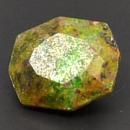|
|
||||||||||||||||
|
||||||||||||||||
|
||||||
|
|
|
|
Soddyite
|
|
| | |
| Discovered in 1922; IMA status: Valid (pre-IMA; Grandfathered) | ||
|
| ||
|
Chemistry |
|
|
| |
|
(UO2)2SiO4 · 2H2O | |
|
|
Hydrated Uranyl Silicate |
|
Molecular Weight: |
668.17 gm |
|
Composition: |
Uranium |
71.25 % |
U |
80.83 % |
UO2 |
|
|
Silicon |
4.20 % |
Si |
8.99 % |
SiO2 |
|
|
Hydrogen |
0.60 % |
H |
5.39 % |
H2O |
|
|
Oxygen |
23.95 % |
O |
|
|
|
|
|
100.00 % |
|
95.21 % |
= TOTAL OXIDE |
|
|
|
||||
|
Classification |
|
|
| |
|
SILICATES (Germanates) | |
|
8/B.36-10 | |
|
|
9 : SILICATES (Germanates)
|
|
Related to: |
n/a |
|
Varieties: |
None |
|
Synonyms: |
None |
|
|
|
|
Crystal Data |
|
|
|
|
|
As crystals of pyramidal to platy habit, to 3 mm. As subparallel to divergent crystal clusters; in cross-fiber veinlets; also massive to earthy. |
|
|
None |
|
|
|
|
|
Physical Properties |
|
|
|
|
|
Perfect on {001}, good on {111} |
|
|
Conchoidal |
|
|
Brittle |
|
|
3.5 |
|
|
4.63 - 4.70 (g/cm3) |
|
|
Fluorescent, Short UV = weak orange yellow, Long UV = weak orange yellow |
|
|
Very Strong; GRapi = 5,126,250.25 (Gamma Ray American Petroleum Institute Units) |
|
|
Health Warning: |
Contains uranium - always wash hands after handling. Avoid inhaling dust when handling or breaking. Never lick or ingest. Avoid prolonged exposure in proximity of the body. Store away from inhabited areas. |
|
|
|
|
Optical Properties |
|
|
|
|
|
Amber to yellow or greenish yellow |
|
|
Transparent, Translucent, Opaque |
|
|
Vitreous to adamantine, dull when earthy |
|
|
1.650 - 1.715 Biaxial ( - ) |
|
|
0.049 - 0.061 |
|
|
Negligible to strong; r > v |
|
|
X = colorless; Y = very pale yellow; Z = pale yellow-green |
|
|
|
|
|
Occurances |
|
|
|
|
|
Geological Setting: |
A secondary mineral formed by oxidation of uraninite. |
|
Common Associations: |
Cuprosklodowskite, Kasolite, Sklodowskite, Uranophane, Torbernite, Curite |
|
Common Impurities: |
n/a |
|
Type Locality: |
Shinkolobwe Mine (Kasolo Mine), Shinkolobwe, Katanga Copper Crescent, Katanga (Shaba), Democratic Republic of Congo (Zaïre) |
|
Year Discovered: |
1922 |
|
View mineral photos: | |
|
|
|
|
More Information |
|
|
|
|
|
| |
|
|
|
|
Soddyite is named after Frederick Soddy (1877 - 1956), British physicist and radiochemist. As with all radioactive minerals always wash hands after handling. Avoid inhaling dust when handling or breaking. Never lick or ingest. Avoid prolonged exposure in proximity of the body. Store away from inhabited areas. Locations
for Soddyite: From Kasolo, Swambo, and in the Musonoi
mine, Kolwezi, Katanga Province, Congo (Shaba Province,
Zaire). At the Norrabees pegmatite, Namaqualand, Cape
Province, South Africa. In the Krunkelbachtal mine,
near Menzenschwand, Black Forest, Germany. In the USA,
in the Ruggles pegmatite, Grafton, Grafton County, New
Hampshire; at the Steel City mine, Yavapai County, Arizona;
from the Jackpile mine, Laguna, Valencia County, New
Mexico; in the Lucky Mc mine, Fremont County, Wyoming;
from the Honeycomb Hills, Juab County, Utah; and at
the Lookout No. 22 claim, Marshall Pass, Saguache County,
Colorado. On Mt. Painter, Flinders Ranges, South Australia,
and from South Alligator Valley, Northern Territory,
Australia. |
|
|
We
have not photographed our Soddyite
gems
yets. Please
check back soon. |
